jump start CHEVROLET KODIAK 2007 Owners Manual
[x] Cancel search | Manufacturer: CHEVROLET, Model Year: 2007, Model line: KODIAK, Model: CHEVROLET KODIAK 2007Pages: 430, PDF Size: 6.06 MB
Page 212 of 430
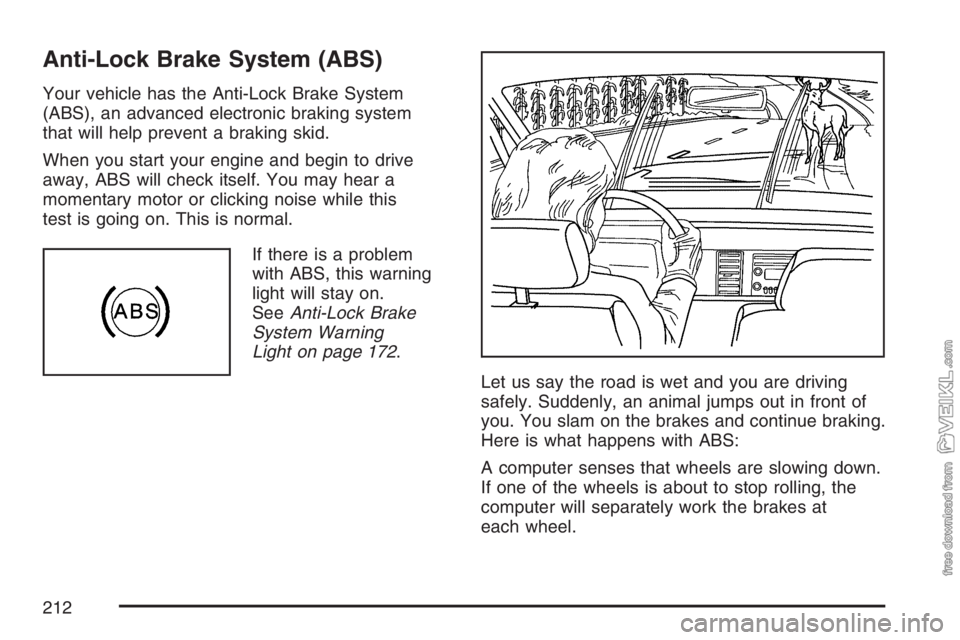
Anti-Lock Brake System (ABS)
Your vehicle has the Anti-Lock Brake System
(ABS), an advanced electronic braking system
that will help prevent a braking skid.
When you start your engine and begin to drive
away, ABS will check itself. You may hear a
momentary motor or clicking noise while this
test is going on. This is normal.
If there is a problem
with ABS, this warning
light will stay on.
SeeAnti-Lock Brake
System Warning
Light on page 172.
Let us say the road is wet and you are driving
safely. Suddenly, an animal jumps out in front of
you. You slam on the brakes and continue braking.
Here is what happens with ABS:
A computer senses that wheels are slowing down.
If one of the wheels is about to stop rolling, the
computer will separately work the brakes at
each wheel.
212
Page 246 of 430
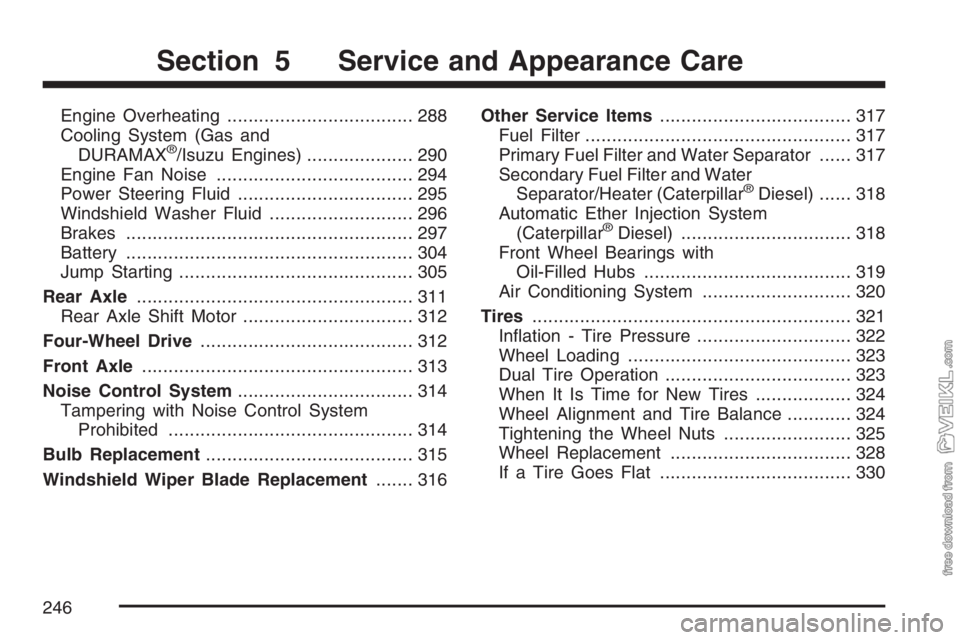
Engine Overheating................................... 288
Cooling System (Gas and
DURAMAX
®/Isuzu Engines).................... 290
Engine Fan Noise..................................... 294
Power Steering Fluid................................. 295
Windshield Washer Fluid........................... 296
Brakes...................................................... 297
Battery...................................................... 304
Jump Starting............................................ 305
Rear Axle.................................................... 311
Rear Axle Shift Motor................................ 312
Four-Wheel Drive........................................ 312
Front Axle................................................... 313
Noise Control System................................. 314
Tampering with Noise Control System
Prohibited.............................................. 314
Bulb Replacement....................................... 315
Windshield Wiper Blade Replacement....... 316Other Service Items.................................... 317
Fuel Filter.................................................. 317
Primary Fuel Filter and Water Separator...... 317
Secondary Fuel Filter and Water
Separator/Heater (Caterpillar
®Diesel)...... 318
Automatic Ether Injection System
(Caterpillar
®Diesel)................................ 318
Front Wheel Bearings with
Oil-Filled Hubs....................................... 319
Air Conditioning System............................ 320
Tires............................................................ 321
Inflation - Tire Pressure............................. 322
Wheel Loading.......................................... 323
Dual Tire Operation................................... 323
When It Is Time for New Tires.................. 324
Wheel Alignment and Tire Balance............ 324
Tightening the Wheel Nuts........................ 325
Wheel Replacement.................................. 328
If a Tire Goes Flat.................................... 330
Section 5 Service and Appearance Care
246
Page 305 of 430
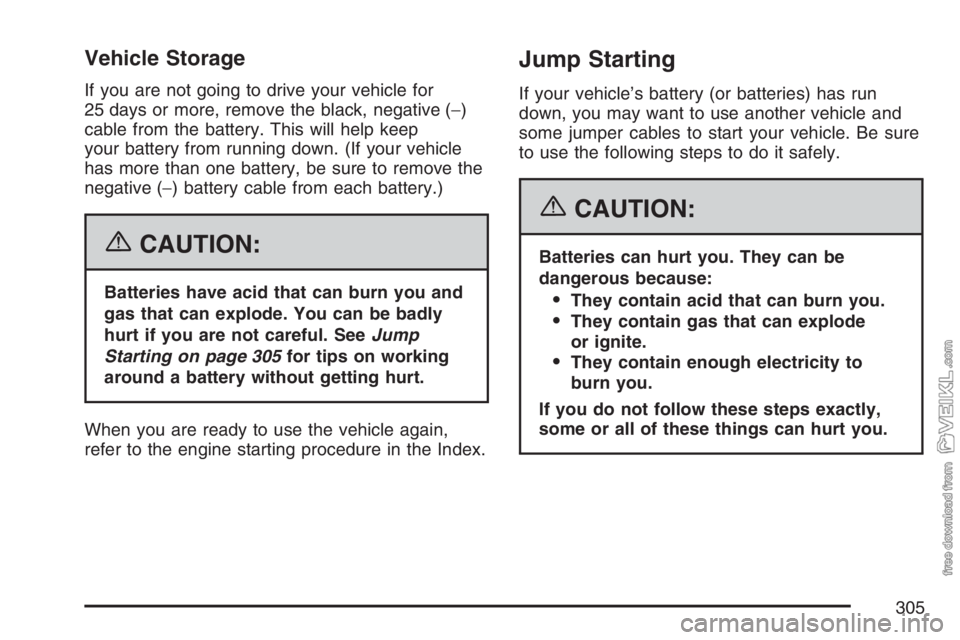
Vehicle Storage
If you are not going to drive your vehicle for
25 days or more, remove the black, negative (−)
cable from the battery. This will help keep
your battery from running down. (If your vehicle
has more than one battery, be sure to remove the
negative (−) battery cable from each battery.)
{CAUTION:
Batteries have acid that can burn you and
gas that can explode. You can be badly
hurt if you are not careful. SeeJump
Starting on page 305for tips on working
around a battery without getting hurt.
When you are ready to use the vehicle again,
refer to the engine starting procedure in the Index.
Jump Starting
If your vehicle’s battery (or batteries) has run
down, you may want to use another vehicle and
some jumper cables to start your vehicle. Be sure
to use the following steps to do it safely.
{CAUTION:
Batteries can hurt you. They can be
dangerous because:
They contain acid that can burn you.
They contain gas that can explode
or ignite.
They contain enough electricity to
burn you.
If you do not follow these steps exactly,
some or all of these things can hurt you.
305
Page 306 of 430

Notice:Ignoring these steps could result in
costly damage to your vehicle that would
not be covered by your warranty.
Trying to start your vehicle by pushing or
pulling it will not work, and it could damage
your vehicle.
1. Check the other vehicle. It must have a
12-volt battery (or batteries) with a negative
ground system.
Notice:If the other vehicle’s system is not a
12-volt system with a negative ground,
both vehicles can be damaged. Only use
vehicles with 12-volt systems with negative
grounds to jump start your vehicle.
If you have a diesel engine vehicle with
two batteries (or more), you should know
before you begin that, especially in cold
weather, you may not be able to get enough
power from a single battery in another
vehicle to start your diesel engine.
If your vehicle has more than one battery, use
the one closest to the starter — this will
reduce electrical resistance.2. Get the vehicles close enough so the jumper
cables can reach, but be sure the vehicles are
not touching each other. If they are, it could
cause a ground connection you do not
want. You would not be able to start your
vehicle, and the bad grounding could damage
the electrical systems.
To avoid the possibility of the vehicles rolling,
set the parking brake firmly on both vehicles
involved in the jump start procedure. Put
an automatic transmission in PARK (P) or a
manual transmission in NEUTRAL before
setting the parking brake. If you have a
four-wheel-drive vehicle, be sure the transfer
case is in a drive gear, not in NEUTRAL.
Notice:If you leave your radio or other
accessories on during the jump starting
procedure, they could be damaged. The repairs
would not be covered by your warranty.
Always turn off your radio and other
accessories when jump starting your vehicle.
3. Turn off the ignition on both vehicles. Unplug
unnecessary accessories plugged into the
cigarette lighter or accessory power outlets.
306
Page 307 of 430
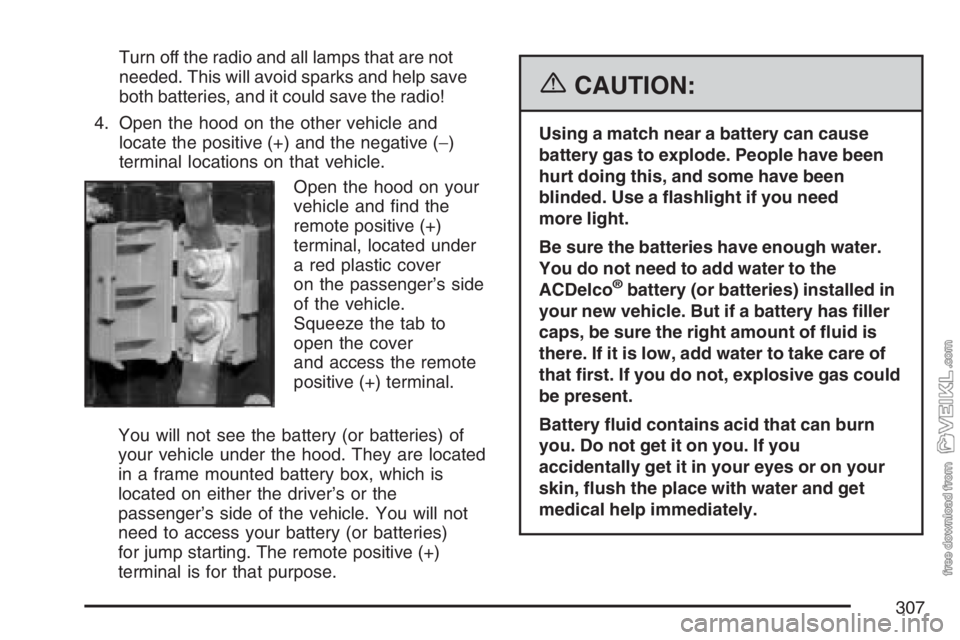
Turn off the radio and all lamps that are not
needed. This will avoid sparks and help save
both batteries, and it could save the radio!
4. Open the hood on the other vehicle and
locate the positive (+) and the negative (−)
terminal locations on that vehicle.
Open the hood on your
vehicle and find the
remote positive (+)
terminal, located under
a red plastic cover
on the passenger’s side
of the vehicle.
Squeeze the tab to
open the cover
and access the remote
positive (+) terminal.
You will not see the battery (or batteries) of
your vehicle under the hood. They are located
in a frame mounted battery box, which is
located on either the driver’s or the
passenger’s side of the vehicle. You will not
need to access your battery (or batteries)
for jump starting. The remote positive (+)
terminal is for that purpose.
{CAUTION:
Using a match near a battery can cause
battery gas to explode. People have been
hurt doing this, and some have been
blinded. Use a �ashlight if you need
more light.
Be sure the batteries have enough water.
You do not need to add water to the
ACDelco
®battery (or batteries) installed in
your new vehicle. But if a battery has �ller
caps, be sure the right amount of �uid is
there. If it is low, add water to take care of
that �rst. If you do not, explosive gas could
be present.
Battery �uid contains acid that can burn
you. Do not get it on you. If you
accidentally get it in your eyes or on your
skin, �ush the place with water and get
medical help immediately.
307
Page 423 of 430
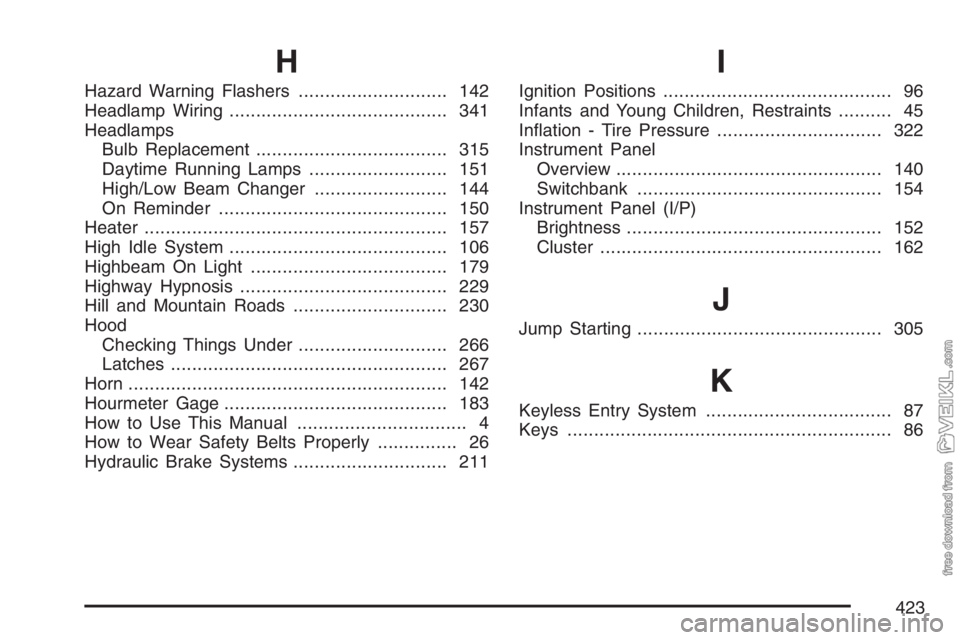
H
Hazard Warning Flashers............................ 142
Headlamp Wiring......................................... 341
Headlamps
Bulb Replacement.................................... 315
Daytime Running Lamps.......................... 151
High/Low Beam Changer......................... 144
On Reminder........................................... 150
Heater......................................................... 157
High Idle System......................................... 106
Highbeam On Light..................................... 179
Highway Hypnosis....................................... 229
Hill and Mountain Roads............................. 230
Hood
Checking Things Under............................ 266
Latches.................................................... 267
Horn............................................................ 142
Hourmeter Gage.......................................... 183
How to Use This Manual................................ 4
How to Wear Safety Belts Properly............... 26
Hydraulic Brake Systems............................. 211
I
Ignition Positions........................................... 96
Infants and Young Children, Restraints .......... 45
Inflation - Tire Pressure............................... 322
Instrument Panel
Overview.................................................. 140
Switchbank.............................................. 154
Instrument Panel (I/P)
Brightness................................................ 152
Cluster..................................................... 162
J
Jump Starting.............................................. 305
K
Keyless Entry System................................... 87
Keys............................................................. 86
423